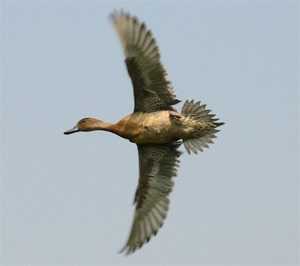Avian Influenza in Birds

Avian influenza refers to infection of birds with avian influenza Type A viruses. These viruses occur naturally among wild aquatic birds worldwide and can infect domestic poultry and other bird and animal species. Wild aquatic birds can be infected with avian influenza A viruses in their intestines and respiratory tract, but usually do not get sick. However, avian influenza A viruses are very contagious among birds and some of these viruses can sicken and even kill certain domesticated bird species including chickens, ducks, and turkeys.
Infected birds can shed avian influenza A viruses in their saliva, nasal secretions, and feces. Susceptible birds become infected when they have contact with the virus as it is shed by infected birds. They also can become infected through contact with surfaces that are contaminated with virus from infected birds.
Avian influenza A viruses are classified into the following two categories: low pathogenic avian influenza (LPAI) A viruses, and highly pathogenic avian influenza (HPAI) A viruses. The categories refer to molecular characteristics of a virus and the virus’ ability to cause disease and mortality in chickens in a laboratory setting [2.5 MB, 64 pages]. Infection of poultry with LPAI viruses may cause no disease or mild illness (such as ruffled feathers and a drop in egg production) and may not be detected. Infection of poultry with HPAI viruses can cause severe disease with high mortality. Both HPAI and LPAI viruses can spread rapidly through poultry flocks. However, some ducks can be infected without any signs of illness.
Avian Influenza in Wild Birds
Avian influenza A viruses have been isolated from more than 100 different species of wild birds. Most of these viruses have been LPAI viruses. The majority of the wild birds from which these viruses have been recovered represent gulls, terns and shorebirds or waterfowl such as ducks, geese and swans. These wild birds are often viewed as reservoirs (hosts) for avian influenza A viruses.
More information about avian influenza in wild birds is available at the USGS National Wildlife Health Center website.
Avian Influenza in Poultry (Domesticated Birds)
Domesticated birds (chickens, turkeys, etc.) may become infected with avian influenza A viruses through direct contact with infected waterfowl or other infected poultry, or through contact with surfaces that have been contaminated with the viruses.
Infection of poultry with LPAI viruses may cause no disease or mild illness and may only cause mild signs (such as ruffled feathers and a drop in egg production) and may not be detected. Infection of poultry with HPAI viruses can cause severe disease with high mortality. Both HPAI and LPAI viruses can spread rapidly through flocks of poultry. HPAI virus infection in poultry (such as with HPAI H5 or HPAI H7 viruses) can cause disease that affects multiple internal organs with mortality up to 90% to 100%, often within 48 hours. Some ducks can be infected without any signs of illness.
Avian influenza outbreaks are of concern in domesticated birds for several reasons:
- the potential for low pathogenic H5 and H7 viruses to evolve into highly pathogenic viruses
- the potential for rapid spread and significant illness and death among poultry during outbreaks of highly pathogenic avian influenza
- the economic impact and trade restrictions from a highly pathogenic avian influenza outbreak
- the possibility that avian influenza A viruses could be transmitted to humans
When H5 or H7 avian influenza outbreaks occur in poultry, depopulation (or culling, also called “stamping out”) of infected flocks is usually carried out. In addition surveillance of flocks that are nearby or linked to the infected flock(s), and quarantine of exposed flocks with culling if disease is detected, are the preferred control and eradication methods. See Past Outbreaks of Avian Influenza in North America for more information about avian influenza A virus infections in U.S. poultry. More information about avian influenza in poultry in the United States is available through the United States Department of Agriculture’s Animal and Plant Health Inspection Service.
Surveillance for Avian Influenza
CDC, the United States Department of Agriculture (USDA), the World Health Organization (WHO), the World Organization for Animal Health (OIE), and the Food and Agriculture Organization of the United Nations (FAO) conduct routine surveillance to monitor influenza viruses for changes that may have implications for animal and public health. CDC and WHO surveillance efforts are focused on human health. FAO and OIE are concerned with issues affecting animals, food and agriculture.
Related Information
- Outbreaks of Avian Influenza A (H5N2), (H5N8), and (H5N1) Among Birds — United States, December 2014–January 2015. MMWR Morb Mortal Wkly Rep 2015;64(Early Release):1
- Page last reviewed: February 6, 2017
- Page last updated: April 14, 2017
- Content source:
- Centers for Disease Control and Prevention, National Center for Immunization and Respiratory Diseases (NCIRD)
- Page maintained by: Office of the Associate Director for Communication, Digital Media Branch, Division of Public Affairs


 ShareCompartir
ShareCompartir